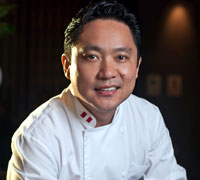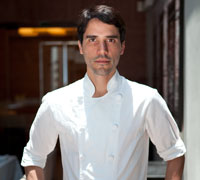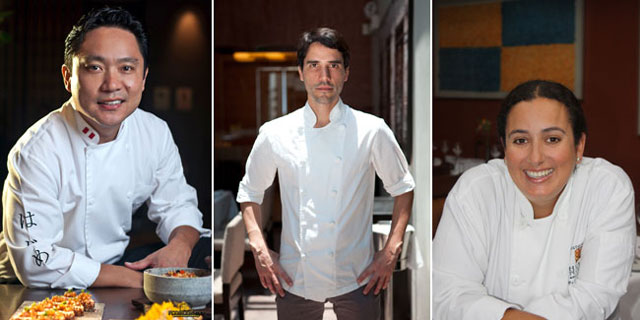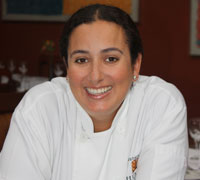Lomo saltado is so yesterday. If you’re looking for what’s next in Peruvian food, these three Peruvian chefs are taking their nation’s cuisine to bold new places.

“There’s more to Peru than Machu Picchu,” jokes Hajime Kasuga, chef owner of Ache restaurant in Lima, as he sips a sinfully intoxicating Pisco cocktail made with berries grown in the Peruvian Amazon. Kasuga, a third-generation Nikkei, or Japanese-Peruvian, is referring to Peru’s worldwide status as a culinary powerhouse.
Ache, named for the Spanish pronunciation of the letter H, opened last May to showcase Kasuga’s laser-focused interpretation of Peruvian food: Nikkei cuisine, a fusion of Peruvian and Japanese cooking styles. At Ache, a maki, or sushi roll, gets the Latin treatment with a crispy quinoa crust instead of the more traditional dusting of sesame. Typical wasabi-based sauces make way for ají amarillo dressings. And the cocktail list includes a fair selection of Pisco-based offerings.
Kasuga’s first restaurant, Hanzo, was where he established himself as an itamae, or master of Japanese cuisine. He names internationally-acclaimed chef Nobu Matsuhisa as an inspiration, and he credits his staff for much of Ache’s success. But he also knows the role food plays in his country. “When Peruvians are sad, they eat. When they’re happy, they eat. When they have a business luncheon, they eat,” he says. “Food is a way of life here.”
Next up, meet Virgilio Martinez from Central.
[ pagebreak ]

Virgilio Martínez, the latest Peruvian to join San Pellegrino’s acclaimed World’s 50 Best Restaurant List, is on a mission. His goal: to raise awareness about the biodiversity of Peru’s plant and animal world as it relates to Peruvian gastronomy. “The Incas lived off the earth,” he relates. “In Peru, we don’t need to label everything organic because it already is.”
Besides Senzo, Martínez’s restaurant in Cuzco, and Central in Miraflores, Martínez introduced Londoners to his brand of Peruvian gastronomy when he opened Lima in London last year. Breaking away from fusion, Martínez is taking Peruvian cuisine back to its origins and reimagining it in a modern way.
“I’m motivated by products that are relatively unknown,” he says. “Wild ingredients fuel my cooking, which revolves around curiosity and a search for the new.”
His approach toward cooking is best illustrated on the tasting menu at Central. Ingredients that are native to Peru’s diverse regions yet not widely known outside these areas are prominently featured: Chonta, a plant from the Amazon that resembles hearts of palm; muña, an herb used in Peru’s mountainous regions for medicinal purposes; and native potatoes and tomatoes rarely seen outside Pachacamac, a Peruvian river valley.
To raise awareness about the sheer scope of Peru’s agricultural bounty, Martínez launched Mater Iniciativa, a collaborative project between academics, chefs and enologists. The goal is to document Peru’s more exotic (and edible) flora and fauna, and educate the public about the diversity of Peruvian gastronomy.
“Peruvians have always had a tremendous respect for the earth,” Martínez says. “The Mater Iniciativa gives life to what we’re trying to accomplish in all of our restaurants.”
Next up, meet Marilu Madueño of Huaca Pucllana.
[ pagebreak ]Marilu Madueño, Huaca Pucllana
Imagine enjoying a succulent filet of grilled paiche, a fish from Peruvian jungle rivers, sipping wine you’ve chosen from a list the size of an oversized library book, and gazing out on a dramatically lit pre-Inca ruin. Two of Peru’s greatest treasures, historic marvels and world-class gastronomy, meet in the most delicious way at Huaca Pucllana, a restaurant built around an architectural site in Lima. Here, chef Marilu Madueño has created a boldly elegant menu fusing Peruvian classics and continental favorites.
Hints of Madueño’s training at Le Cordon Bleu Paris appear in dishes such as chicken breast stuffed with cheese and leeks in an ají amarillo sauce, and a duck in mustard sauce with yucca gratin. “I’ve created a menu with a lot of fusion,” she notes, “but I do include some traditional recipes so that if you want to try causa, you can.”
Food is not the only way Madueño honors her Peruvian heritage. Her business partner was awarded a license to operate a restaurant on an archaeological site, and Madueño donates a percentage of her proceeds toward the restoration of the 1,500-year-old Huaca Pucllana, a sacred place that, fittingly, once served as a trade center for Peruvian agricultural products.
Red Quinoa-Crusted Sea Bass with an Artichoke Asparagus Stir Fry in a Balsamic Reduction
- 1 500 ml bottle balsamic vinegar
- 2 cups red wine
- 1 pound plus 1 1/2 ounces sugar
- 1 tablespoon butter
- kosher salt, to taste
- 4 7-ounce sea bass filets
- 3 1/2 ounces all-purpose flour
- 1 egg, beaten
- 7 ounces red quinoa, cooked al dente
- 3 ounces olive oil




![Making Mealtime Matter with La Familia: Easy Sofrito [Video]](https://thelatinkitchen.com/wp-content/uploads/2015/10/sofrito-shutterstock__0-500x383.jpg)
![Easy Latin Smoothies: Goji Berry Smoothie [Video]](https://thelatinkitchen.com/wp-content/uploads/2015/12/goji_berry-shutterstock_-500x383.jpg)
















![Fun and Fast Recipes: Fiesta Cabbage Salad [Video]](https://thelatinkitchen.com/wp-content/uploads/2015/11/fiesta_cabbage_slaw-shutterstock_-500x383.jpg)









